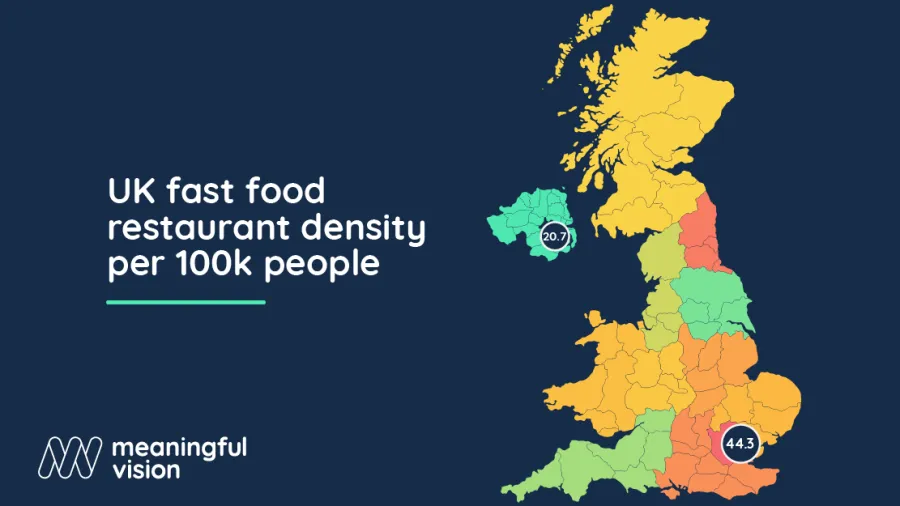
Why are there fewer fast-food outlets per capita in the UK’s top cities?
Major cities Manchester and Birmingham do not even make it into the top 20.
In August 2023, there are 29 fast food chain outlets per 100,000 people in the UK, but this nationwide average deviates significantly from the median when examining the data by region, a report by Meaningful Vision has revealed.
Analysing 70 of the largest fast-food chains operating in the UK, the report encompasses all categories of restaurants, including quick-service burger restaurants, chicken shops, bakeries and sandwich shops, coffee shops, Asian food, and pizza deliveries.
Operators assess the potential to open new outlets in a particular region by looking at the density expressed by the ratio of restaurants per 100,000 people
READ MORE: Prices increased faster for cheaper menu items
London leads with 44 fast-food outlets per 100,000 people, followed closely by the North East with 34, the South East with 33, and the East Midlands with 30.
Interestingly, Meaningful Vision’s data revealed that Portsmouth leads with the highest density of fast-food restaurants. The top ten towns or cities with the most fast-food outlets per capita are as follows:
- Portsmouth – 57
- Gateshead – 49
- Edinburgh – 49
- Blackpool – 48
- Cardiff – 46
- Milton Keynes – 45
- Guilford – 45
- London – 44
- Leeds – 41
- Newcastle – 40
Major cities like London, ranked at a low eight and some like Manchester and Birmingham do not even make it into the top 20.
Distribution of fast-food outlet types
Fast-food outlet types could also play a part in the difference in the regional distribution of fast-food chain outlets compared to cities.
For example, Meaningful Vision’s data said burger restaurants are evenly distributed across the country. On average, the difference between the most densely populated fast-food points in regions and the least populated ones is 2 times, for burgers, this difference is only 1.5.
Amongst cities, Gateshead, Ashford, Portsmouth, Blackpool, and Cardiff have the highest number of burger joints per capita – more than 6 per 100,000 people.
These cities outpace London, where the point density is 4.2. The lower number for London may be attributed to a higher number of fast-casual and casual dining burger establishments. Belfast also ranks high in this category - 5.6, despite Northern Ireland having fewer chain fast-food outlets on average. Stockport - 2.0, Bradford - 2.2, and Wolverhampton - 2.3, however, find themselves at the bottom of this list.
ALSO READ: How this family-owned fried chicken business idea hatched during the pandemic
Meanwhile, the towns or cities with the highest number of bakeries and sandwich shops per capita are Gateshead at 22 per 100,000, Portsmouth - (20), Blackpool and Newcastle (18), Stockton-on-Tees (15).
In contrast, Bedford, Plymouth, and St. Albans exhibit significantly lower numbers, with a density of outlets approximately one-third that of the leading cities. York and Cambridge also have modest numbers in this category, whilst Oxford (11), boasts nearly 30% more bakeries and sandwich shops, than Cambridge (8).
In the domain of chain coffee shops per 100,000 Edinburgh (19), Portsmouth (17), and Chester (15) stand out with the highest density. Notably, London lags behind Chester in this aspect, boasting 11 coffee shops per capita compared to Chester's 15. Leeds, as well as university cities such as Oxford, Exeter, and Bath, secure positions in the top ten. In stark contrast, Wolverhampton reports the lowest density of coffee shops, with six times fewer outlets per capita compared to Edinburgh (3).
Chicken fast-food outlets are predominantly concentrated in suburban areas of London, including Croydon (11), Harrow (7), and Romford (6). In contrast, cities like York, Norwich, and Bath have seven times fewer chicken outlets than the leading locales. However, these cities tend to have more burger shops than the national average.
Pizzerias, meanwhile, are the least evenly distributed across regions. Unlike burger shops, the difference between the most densely populated region and the region with the lowest density is 3 times. Ashford, Milton Keynes, High Wycombe, Blackpool, and Aberdeen have 7 or more delivery pizza outlets per 100,000 people. Oldham and Bradford complete the list with a rate of fewer than 1.5 points per 100,000.
Factors affecting density
The overall density of foodservice establishments per 100,000 in London stands at 44.
However, the distribution of these establishments across different areas of the city reveals considerable differences. The highest concentration is observed in Central London, boasting 208 outlets per 100,000 people. Conversely, the East of London lags significantly behind, with nearly seven times fewer fast-food outlets, numbering only 29 per 100,000 people, a figure that closely mirrors the national average.
According to Maria Vanifatova, CEO of Meaningful Vision, despite fast-food dominating the UK foodservice market, the variation in the distribution of outlets across different regions, cities, and towns, is not always apparent.
“This variation can be attributed to a range of factors, including demand, business activity levels, age demographics, ethnic composition, and supply, i.e., the availability of suitable sites. When analysing chain operational performance with a view to optimising or expanding the business, accurate data on the number of competing outlets in the studied region is crucial. This information, combined with data on the average turnover, foot traffic, pricing etc. of outlets in that region, is crucial to making successful strategic decisions regarding the opening of new restaurants,” Vanifatova said.



























